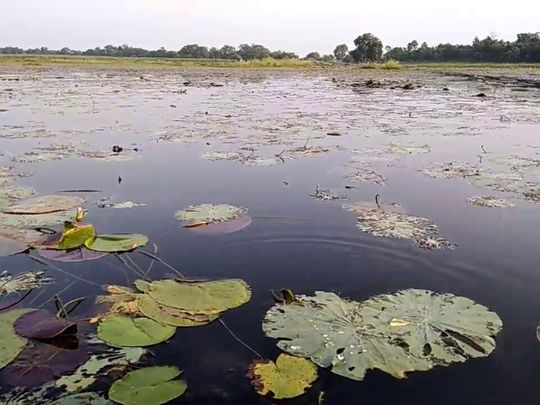
Patna: Kanwar lake, Asia’s largest freshwater oxbow lake located in Bihar, faces the threat of running dry owing to the unrestrained encroachment of land and government’s inaction to save the natural aquifer which has been the preferred destination of the tourists.
Located in Begusarai district, 125 km north of Patna, the lake was originally spread over in 6,786 hectares but now it has got reduced to little over 2,500 hectares, indicating how fast the encroachers have got involved in the business.
According to environmentalists, it is a residual oxbow lake, formed due to meandering of mighty Gandak, a tributary of the Ganges, and served many purposes to the local populace—from recharging the groundwater and fishing to irrigating the agricultural field. Apart from being a valuable site for fish diversity with over 50 species documented, this wetland, also known as Kabar Taal lake, served as an important stopover along the Central Asian Flyway with at least 58 migratory water birds using it to rest and refuel. But today, the wetland is shrinking very fast.
Declining fast
“The depth of the lake is declining fast due to infestation of aquatic weeds. Besides excessive use of groundwater for irrigation in the protected areas has taken a heavy toll,” said environmentalist Ashok Ghosh who has conducted an extensive study on this lake. Ghosh’s study also found that some 60 per cent of the land is under illegal farming while some five per cent is being used for non-agricultural purposes.
Another environmentalist said the construction of an embankment on Old Gandak river near the lake has choked the major water inlet to the wetland and left it primarily dependent on rainwater.
“We are seeking helps from the water resources department to ensure smooth flow of water from Gandak river to the lake,” Bihar’s forest and environment department secretary Dipak Kumar Singh told the local media on Thursday.
An environment officer with United Nations Development Project Kumar Deepak said the huge stretch of wetland has been a boon for local farmers since it absorbs considerable amount of water during flooding and offer land for cultivation during summer.
“The natural water reservoir has been serving the society in many ways, such as income generation through fishery, recharging groundwater and promoting tourism,” Kumar told the local media.
Protected area
Environmentalists said the lake was once the nestling ground for 165 plant species, 394 animal species, including 221 bird species but today it’s a dying ecosystem due to continued poaching of resident as well as migratory birds. This goes on despite being notified as a protected area by the Bihar state government in 1986. The lake has been a home to 58 migratory birds, according to environmentalists.
The Kanwar lake which is six times bigger than Bharatpur bird sanctuary in Rajasthan was declared a “Ramsar site” last year following a sustained campaigns by environmentalists across the globe. “Ramsar sites” are wetlands of international significance under the Ramsar convention, an international treaty for conservation and sustainable use of wetlands. It is named after the city of Ramsar in Iran where the convention was signed in 1971.
The news was shared by none other than federal minister of environment, forest and climate change Prakash Javadekar on his twitter handle. “Pleased to inform that Bihar has got its first Ramsar site. Kabar Taal in Begusarai becomes a wetland of international importance. It is an important wetland for central Asian Flyway for its population of migratory birds and biodiversity. With this, India now has 39 Ramsar sites,” the minister tweeted.








